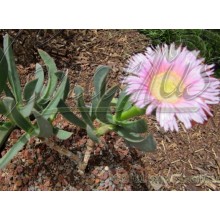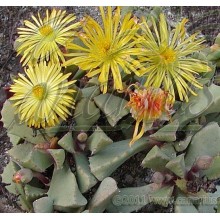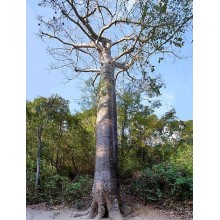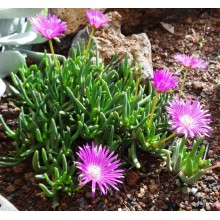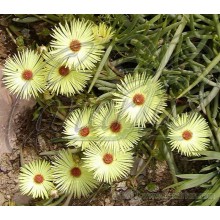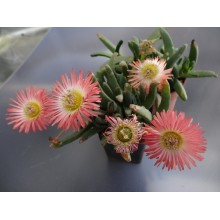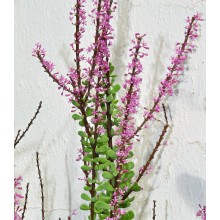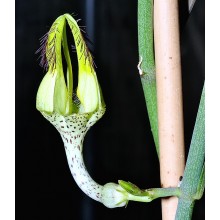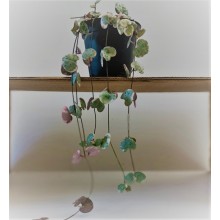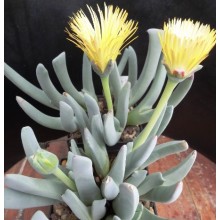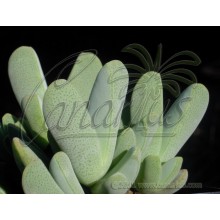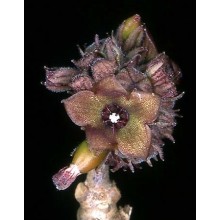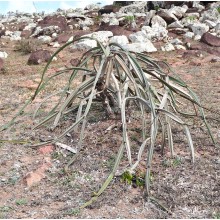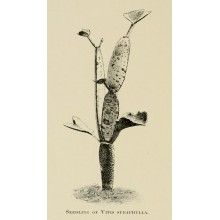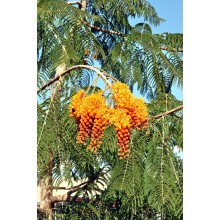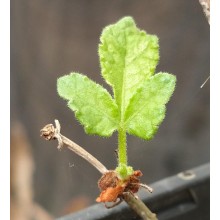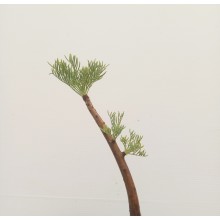Succulente Ci sono 628 prodotti.

I deserti del mondo e le zone secche ospitano le piante più interessanti. Canarius offre una selezione crescente di piante succulente di massima qualità, perché sono coltivate all'aperto, in pieno sole delle Isole Canarie.
I succulente o "piante grasse" sono specie di ritenzione di acqua, adattate alle condizioni di asciutto. Loro accumulano succum (succo, acqua) nelle loro foglie, steli o radici, e spesso mostrano un aspetto robusto e carnoso.
Sotto-categorie
-
Agave
Agave è un genere di piante grasse provenienti dall'America. Alcune specie crescono in zone fredde e possono sopportare un forte gelo, mentre altri vivono in climi tropicali. Alcuni sono piccoli nani e alcuni sono giganti, fino a 2 o 3 m di larghezza.
Le agavi resistenti al freddo possono creare un effetto esotico nel vostro giardino. Le specie agave fanno bella compagna di palme o cactus. Le agavi variegate sono incredibilmente ricercati dai collezionisti. Il nostro negozio web offre una selezione in continua evoluzione delle specie. Spediamo piante a radice nuda, se non diversamente specificato.
-
Aloe, Gasteria & Haworthia
Aloe, Gasteria e Haworthia sono tre generi correlate, comprese centinaia di piante succulente. Sono tutti facilmente coltivate in vaso. Alcuni si adattano a bassi livelli di luce di condizioni interne e possono essere coltivate come piante da appartamento.
- Aloe è un genere di circa 400 specie, originarie di Africa, Arabia e Madagascar. I aloe piccoli o nani stanno diventando particolarmente popolare in climi più freddi in quanto possono essere presi in casa durante i mesi più duri.
- Gasteria comprende circa 80 specie endemiche in Sud Africa, conosciuti per le loro foglie spettacolari che sono lucide, screziati e ruvidi. Fioriscono in primavera-estate con lunghe punte di piccoli fiori arancioni. Alcune specie sono talmente variabile che offriamo cloni particolari di località specifiche.
- Haworthia è un genere endemico in Sud Africa con circa 70 specie e un certo numero di sottospecie locali, varietà e forme. Le foglie sono spesso banded, punteggiati, punteggiato, o semi-trasparente e mostrano ampie variazioni.
-
Crassule
Questa è una nuova e crescente sezione di specie della famiglia Crassulaceae. Ci sono circa 1.400 specie in 33 generi et la loro distribuzione è in tutto il mondo, ma si presentano più nell'emisfero Nord e Sud Africa, in particolare in ambienti asciutti. Qui si possono acquistare piante sani, indurito dal sole, coltivati nelle isole Canarie e spediti a casa tua.
-
Mesembriantemi
Questo gruppo di piante del deserto è chiamato Mesembriantemi perché appartengono a una famiglia botanica precedentemente denominata Mesembryanthemaceae. Ci sono quasi 2.000 specie, che si trovano principalmente in Africa del sud, con adattamenti estremi agli habitat secco. Alcuni sono chiamati "pietre vive", perché sembrano come ciottoli. Molti sono facili da coltivare e il loro bisogno principale è pieno sole. Alcuni sono difficili perché crescono nelle aree veramente estreme.
Il nostro Web Shop offriamo piante sane coltivate al sole, con foglie compatte e colorate. Alcune piante sono venduti come talee, e altri come piante radicate, di almeno due anni. -
Sansevieria
Recentemente assegnato alla famiglia Asparagaceae, il genere Sansevieria conta circa 70 specie, quasi tutti nativi in Africa, Arabia e Madagascar. Erbe perenni adatti per gli habitat secchi con foglie rigide, succulente, la loro lunghezza varia da pochi centimetri a 2 metri. Sansevieria trifasciata e le sue numerose cultivar sono tra le piante d'appartamento più apprezzati, popolarmente chiamata la lingua di suocera. Una pianta ben coltivata di solito produce un picco di molti fiori bianchi, riccamente profumati e poi bacche arancioni. Anche le specie più rare sono resistenti ad abbandono, a condizione di tenerli dal gelo in inverno e sole cocente in estate.
-
Hoya
Le Hoyas sono rampicanti, dai fiori esotici e spesso vistosi. Provengono dalle foreste pluviali in Asia e Oceania. La maggior parte delle specie vive bene a mezz' ombra e si adatanno a vivere in casa come piante da appartamento. Sono ideali per cesti e tralicci. Tollerano un paio di settimane di siccità, ma sono sensibili al gelo e freddo. Molte hoya i sono facili da far crescere e fiorire, mentre alcune sono difficili e rare.
-
Asclepiadaceae
Le Asclepiade, o Asclepiadoideae, sono una sottofamiglia delle Apocynaceae, che annoverano circa 2900 specie diverse. Tra queste si trovano molti fusti privi di foglie ma anche erbe perenni, arbsuti, liane e, raramente, alberi. Producono fiori molto belli, dato il complesso sistema di impollinazione. Molte specie producono un odore insolito, spesso associato a quello di una carogna, la cui funzione è quella di attrarre le mosche che poi andranno a impollinare i fiori. -
Caudiciformi
Queste piante, dette anche pachicauli, sono tipiche delle zone aride. Producono un tronco insolitamente grosso e sproporzionato, detto caudice (a volte anche tubero), spesso con ramificazioni. Il caudice può essere anche nascosto sottoterra, ma nella maggior parte dei casi ha sviluppo verso l'alto, dando luogo ad alberi dalla forma spettacolare. I caudiciformi più grandi sono i baobab. -
Altre succulente
Qui troverete tutte quelle specie di piante del deserto che non sono inclusi nella propria categoria. Metteremo qui tutte le piante provenienti da famiglie inusuali, diversi da Agavi, Aloe, Crassulaceae, Sansevieria, Mesembriantemi, Epiphytic cacti, etc.
-
Carpobrotus mellei
Carpobrotus mellei
Endemic to the inland mountains in the SW Cape ofS Africa. It easily blooms in pots and does not need to bein the ground. It is the only mountain Carpobrotus and does not need a coastal climate. Leaves contain natural antibi
11,90 € -
Carruanthus ringens
Carruanthus ringens
Branched plant, Cont.= 8,5 cm. Native to the Little Karoo in South Africa, this species in an opportunistic grower and can rest or grow in about any time of the year.
10,80 € -
Cavanillesia platanifolia
Cavanillesia platanifolia
In short words, this is the American Baobab. This American bottle tree is related to true baobabs of the genus Adansonia, which are only found in Africa, Madagascar and Australia: Cavanillesia also looks similar in habit because of its gigantic swollen trunk
78,60 € -
Cephalophyllum alstonii Pink Form
Cephalophyllum alstonii Pink Form
Pink flowered form of an easy, creeping species, often used as a ground cover. It has beautiful glaucous leaves, triangular in section. Abundant bright flowers in winter, spectacular. It grows wild in the Ceres Karoo in a winter rainfall area. Protect from heavy frost .
10,40 € -
Cephalophyllum pillansii
Cephalophyllum pillansii
Branched plant. Cont.= 6 cm. Mat-forming South African succulent with gray-green leaves. Flowers are beautiful, glossy light yellow with dark centers. It blooms in spring and often repeats in Summer.
10,70 € -
Cephalophyllum spissum
Cephalophyllum spissum
Pink flowered form of an easy, creeping species, often used as a ground cover. It has beautiful glaucous leaves, triangular in section. Abundant bright flowers in winter, spectacular. It grows wild in the Ceres Karoo in a winter rainfall area. Protect from heavy frost .
10,20 € -
Ceropegia ampliata
Ceropegia ampliata
Rare succulent twiner from South Africa. It produces groups of 2-4 large, exotic, unusual flowers, opening one after the other, about 6 cm long, pale green to white.
20,80 € -
Ceropegia juncea
Ceropegia juncea
Scrambling or climbing ceropegia from India with tuberous roots and almost leafless stems. Leaves are fleshy and diminute, sparsely distributed and lance-shaped. Flowers are large, lantern-shaped, lime-yellow in colour and nicely speckled in green and purple. They are also decorated by pink "hairs"!
36,80 € -
Ceropegia woodii variegata
Ceropegia woodii variegata
Ceropegia woodii is a flowering plant in the dogbane family Apocynaceae, native to South Africa, Eswatini and Zimbabwe. It is an evergreen succulent trailing vine that grows to 10 centimetres (3.9 in) in height and spreads to reach up to 2–4 metres (6 ft 7 in – 13 ft 1 in) in length.
38,50 € -
Cheiridopsis candidissima
Cheiridopsis candidissima
Cont.= 12 cm. Huge Plant with >8 heads. Beautiful plant from the Little Karoo, with large, greyish V-shaped leaves. With age, leaf tips form elegant teeth. Large cream to yellow flowers. Full sun to light shade. Keep drier in summer.
10,80 € -
Cheiridopsis purpurea
Cheiridopsis purpurea
NEW! - Branched plant, Cont.= 12 cm. Purple flowered compact mesemb, native to the Richtersveld in South Africa. It grows in full sun to light shade. Keep drier in Summer. Tolerant of light frost.
10,80 € -
Cibirhiza dhofarensis
Cibirhiza dhofarensis
1 year old seedling, caudex: about 1 cm. This slow and hard to find asclepiad is endemic to the region of Dhofar, in Oman. Its tuberous roots are edible, but we think our customers will never have one for lunch!
35,00 € -
Cissus hamaderohensis
Cissus hamaderohensis
Succulent shrub from upland Socotra. This Cissus has flat grey stems, they can be scrambling, creeping or even climbing. We offer a rooted cutting, with one ore more new growths.
27,50 € -
Cissus subaphylla
Cissus subaphylla
Succulent shrubby Cissus from the island of Socotra. Stems are flat, grey and succulent. It grows erect when young, while adult plants infull sun eventually form a dome-shaped shrub of perfectly interlocked stems.
32,50 € -
Commiphora boranensis
Commiphora boranensis
Fairly uncommon in cultivation, this mhyrr shrub to 6 m tall has pinnate leaves, often with 3 or 5 segments and dark, peeling bark with copper tones. Commiphora boranensis is native to in the desert or dry shrubland in Eastern Africa.
48,30 € -
Commiphora kraeuseliana
Commiphora kraeuseliana
Very elegant, short-growing mhyrr from open rocky areas in Northern Namibia, Commiphora kraeuseliana is a small deciduous shrub, densely and regularly branched.
94,60 €
Al momento ci sono pochi prodotti in questa categoria Succulente

























